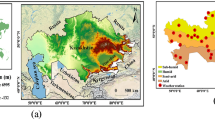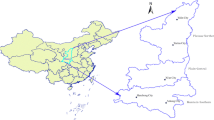Abstract
Drought research is of great importance for planning and management of water resources, due to the great impact that droughts have on society and ecosystems. In this study, the effect that using different models for calculating evapotranspiration has on the analysis of droughts in the semiarid region of North Central Mexico is investigated, using climatological information from 14 meteorological stations. Drought was analyzed using the Reconnaissance Drought Index (RDI) and the Standardized Precipitation Evapotranspiration Index (SPEI) at the scales of 3, 6 and 12 months. Eight evapotranspiration models were used: those of Thornthwaite, Hargreaves – Samani, Droogers – Allen, Allen, Dorji, Priestley – Taylor, Makkink and Irmak. According to three of the efficiency indices that were used – the root mean squared error (RMSE), the medium absolute error (MAE) and the concordance index – the Hargreaves – Samani model yields the best evapotranspiration results as compared to the Penman–Monteith model, whereas the models of Thornthwaite and Dorji are the least recommended for this purpose. The non-parametric Wilcoxon test, at a 5% significance level, leads to the conclusion that there are no statistically significant differences between the RDI and SPEI drought indices calculated using the Thornthwaite or the Hargreaves – Samani model. At the three scales of analysis, differences in the RDI index calculated using evapotranspiration estimated with the Thornthwaite or the Hargreaves – Samani model are minimal, but are slightly larger for the SPEI index. Drought events detected with the RDI and SPEI indices are more intense when the Thornthwaite model is used to calculate evapotranspiration instead of the Hargreaves – Samani model. These results may prove valuable in the analysis of droughts, especially in arid and semiarid regions.




Similar content being viewed by others
References
Allen RG (1993) Evaluation of a temperature difference method for computing grass reference evapotranspiration. Report to Water Resources Development and Management Service Land and Water Development Division. FAO. Rome, Italy
Allen RG, Pereira LS, Raes D, Smith M (1998) Crop evapotranspiration: Guidelines for computing crop water requirements. FAO Irrigation and Drainage Paper 56. Rome, Italy
Azhar AH, Perera B (2010) Evaluation of reference evapotranspiration estimation methods under southeast Australian conditions. J Irrig Drain Eng ASCE 137:268–279. https://doi.org/10.1061/(ASCE)IR.1943-4774.0000297
Bayissa Y, Maskey S, Tadesse T, van Andel SJ, Moges S, van Griensven A, Solomatine D (2018) Comparison of the performance of six drought indices in characterizing historical drought for the Upper Blue Nile Basin. Ethiopia Geosci 8:81. https://doi.org/10.3390/geosciences8030081
Blaney HF, Criddle WD (1950) Determining water requirements in irrigated areas from climatological and irrigation data. Soil Conservation Service Technical Paper 96. Soil Conservation Service. Washington, US Department of Agriculture
Comisión Nacional del Agua (CONAGUA) (2018) Estadisticas del Agua en México, edición 2018. Secretaría de Medio Ambiente y Recursos Naturales. Ciudad de México
Comisión Nacional del Agua (CONAGUA) (2020) Base de datos climatológica nacional. CLIma COMputarizado (CLICOM) system. https://smn.conagua.gob.mx/es/climatologia/informacion-climatologica/informacion-estadistica-climatologica. Accessed 5 Nov 2020
Dai A (2011) Drought under global warming: a review. Wiley Interdiscip Rev Clim Change 2:45–65. https://doi.org/10.1002/wcc.81
Dorji U, Olesen JE, Seidenkrantz MS (2016) Water balance in the com- plex mountainous terrain of Bhutan and linkages to land use. J Hydrol Reg Stud 7:55–68. https://doi.org/10.1016/j.ejrh.2016.05.001
Droogers P, Allen RG (2002) Estimating reference evapotranspiration under inaccurate data conditions. Irrig Drain Sys 16:33–45. https://doi.org/10.1023/A:1015508322413
Gocic M, Trajkovic S (2010) Software for estimating reference evapotranspiration using limited weather data. Comput Electron Agric 71:158–162. https://doi.org/10.1016/j.compag.2010.01.003
Halwatura D, McIntyre N, Lechner AM, Arnold S (2017) Capability of meteorological drought indices for detecting soil moisture droughts. J Hydrol Reg Stud 12:396–412. https://doi.org/10.1016/j.ejrh.2017.06.001
Hargreaves GH, Samani ZA (1985) Reference crop evapotranspiration from temperature. Appl Eng Agric 1:96–99. https://doi.org/10.13031/2013.26773
Heim RR Jr (2002) A review of twentieth-century drought indices used in the United States. Bull Am Meteor Soc 83:1149–1165. https://doi.org/10.1175/1520-0477-83.8.1149
Hisdal H, Tallaksen LM (2003) Estimation of regional meteorological and hydrological drought characteristics. J Hydrol 281:230–247. https://doi.org/10.1016/S0022-1694(03)00233-6
Instituto Nacional de Estadística y Geografía (INEGI) (2015) Anuario estadístico y geográfico de Zacatecas 2015. Instituto Nacional de Estadística y Geografía, México
Irmak S, Irmak A, Allen RG, Jones JW (2003) Solar and net radiation-based equations to estimate reference evapotranspiration in humid climates. J Irrig Drain Eng ASCE 129(5):336–347. https://doi.org/10.1061/(ASCE)0733-9437(2003)129:5(336)
Jensen ME, Haise HR (1963) Estimating evapotranspiration from solar radiation. Proceedings of the American Society of Civil Engineers. J Irrig Drain Div 89:15–41
Khanmohammadi N, Rezaie H, Behmanesh J (2018) The spatial–temporal variation of dry and wet periods in Iran based on comparing SPI and RDI indices. Stoch Env Res Risk A 32:2771–2785. https://doi.org/10.1007/s00477-018-1594-1
López-Urrea R, de Santa M, Olalla F, Fabeiro C, Moratalla A (2006) Testing evapotranspiration equations using lysimeter observations in a semiarid climate. Agr Water Manage 85:15–26. https://doi.org/10.1016/j.agwat.2006.03.014
Makkink GF (1957) Testing the Penman formula by means of lysimeters. J Inst Water Eng 11:277–288
McEvoy DJ, Huntington JL, Abatzoglou JT, Edwards LM (2012) An evaluation of multiscalar drought indices in Nevada and eastern California. Earth Interact 16:1–18. https://doi.org/10.1175/2012EI000447.1
McKee TB, Doesken NJ, Kleist J (1993) The relationship of drought frequency and duration to time scales. Eight Conference on Applied Climatology. American Meteorological Society: Anaheim, CA, USA, pp 179–184
Mishra AK, Singh VP (2009) Analysis of drought severity-area- frequency curves using a general circulation model and scenario uncertainty. J Geophys Res-Atmos 114(D6):D06120. https://doi.org/10.1029/2008JD010986
Mohammed R, Scholz M (2017a) Impact of evapotranspiration formulations at various elevations on the Reconnaissance Drought Index. Water Resour Manag 31:531–548. https://doi.org/10.1007/s11269-016-1546-9
Mohammed R, Scholz M (2017b) The reconnaissance drought index: a method for detecting regional arid climatic variability and potential drought risk. J Arid Environ 144:181–191. https://doi.org/10.1016/j.jaridenv.2017.03.014
Ortiz-Gómez R, Cardona-Díaz JC, Ortiz-Robles FA, Alvarado-Medellin P (2018) Characterization of droughts by comparing three multiscale indices in Zacatecas, Mexico. Tecnol Cienc Agua 9(3):47–91. https://doi.org/10.24850/j-tyca-2018-03-03
Palmer WC (1965) Meteorological drought. Research Paper No. 45. US Department of Commerce, Weather Bureau, Washington D.C.
Penman HL (1948) Natural evaporation from open water, bare soil and grass. Proc Math Phy Eng Sci 193:120–145. https://doi.org/10.1098/rspa.1948.0037
Priestley CHB, Taylor RJ (1972) On the assessment of surface heat flux and evaporation using large scale parameters. Mon Weather Rev 100:81–92. https://doi.org/10.1175/1520-0493(1972)100%3C0081:OTAOSH%3E2.3.CO;2
Rohwer C (1931) Evaporation from free water surface. USDA Tech Null 217:1–96
Romanenko VA (1961) Computation of the autumn soil moisture using a universal relationship for a large area. In: Proceedings, Ukrainian Hydrometeorological Research Institute, No. 3. Kiev
Sheffield J, Wood EF, Roderick ML (2012) Little change in global drought over the past 60 years. Nature 491:435–438. https://doi.org/10.1038/nature11575
Tabari H (2010) Evaluation of reference crop evapotranspiration equations in various climates. Water Resour Manag 24:2311–2337. https://doi.org/10.1007/s11269-009-9553-8
Thornthwaite CW (1948) An approach toward a rational classification of climate. Geogr Rev 38:55–94. https://doi.org/10.2307/210739
Tigkas D, Vangelis H, Tsakiris G (2012) Drought and climatic change impact on streamflow in small watersheds. Sci Total Environ 440:33–41. https://doi.org/10.1016/j.scitotenv.2012.08.035
Tigkas D, Vangelis H, Tsakiris G (2020) Implementing crop evapotranspiration in RDI for farm-level drought evaluation and adaptation under climate change conditions. Water Resour Manag 34:4329–4343. https://doi.org/10.1007/s11269-020-02593-6
Tirivarombo S, Osupile D, Eliasson P (2018) Drought monitoring and analysis: Standardised Precipitation Evapotranspiration Index (SPEI) and Standardised Precipitation Index (SPI). Phys Chem Earth 106:1–10. https://doi.org/10.1016/j.pce.2018.07.001
Tsakiris G, Vangelis H (2005) Establishing a drought index incorporation evapotranspiration. Eur Water 9(10):3–11
Tsakiris G, Pangalou D, Vangelis H (2007) Regional drought assessment based on the Reconnaissance Drought Index (RDI). Water Resour Manag 21:821–833. https://doi.org/10.1007/s11269-006-9105-4
Van der Schrier G, Jones PD, Briffa KR (2011) The sensitivity of the PDSI to the Thornthwaite and Penman-Monteith parameterizations for potential evapotranspiration. J Geophys Res-Atmos 116:D03106. https://doi.org/10.1029/2010JD015001
Vangelis H, Tigkas D, Tsakiris G (2013) The effect of PET method on Reconnaissance Drought Index (RDI) calculation. J Arid Environ 88:130–140. https://doi.org/10.1016/j.jaridenv.2012.07.020
Vicente-Serrano SM, Beguería S, López-Moreno JI (2010) A multi-scalar drought index sensitive to global warming: the standardized precipitation evapotranspiration index-SPEI. J Clim 23:1696–1718. https://doi.org/10.1175/2009JCLI2909.1
Vicente-Serrano SM, Van der Schrier G, Beguería S, Azorin-Molina C, Lopez-Moreno J-I (2015) Contribution of precipitation and reference evapotranspiration to drought indices under different climates. J Hydrol 526:42–54. https://doi.org/10.1016/j.jhydrol.2014.11.025
Yagci AL, Di L, Deng M (2013) The effect of land-cover change on vegetation greenness-based satellite agricultural drought indicators: a case study in the southwest climate division of Indiana, USA. Int J Remote Sens 34:6947–6968. https://doi.org/10.1080/01431161.2013.810824
Yuan S, Quiring SM (2014) Drought in the U.S. Great Plains (1980–2012): a sensitivity study using different methods for estimating potential evapotranspiration in the Palmer Drought Severity Index. J Geophys Res-Atmos 119:10996–11010. https://doi.org/10.1002/2014JD021970
Yue Y, Shen S-h, Wang Q (2018) Trend and variability in droughts in Northeast China based on the Reconnaissance Drought Index. Water 10:318. https://doi.org/10.3390/w10030318
Zarch MAA, Malekinezhad H, Mobin MH, Mastorani MT, Kousari MR (2011) Drought monitoring by Reconnaissance Drought Index in Iran. Water Resour Manage 25:3485–3504
Zarei AR, Mahmoudi MR (2017) Evaluation of changes in RDIst index effected by different potential evapotranspiration calculation methods. Water Resour Manag 31:4981–4999. https://doi.org/10.1007/s11269-017-1790-7
Zarei AR, Moghimi MM, Bahrami M (2019) Comparison of reconnaissance drought index (RDI) and effective reconnaissance drought index (eRDI) to evaluate drought severity. Sustain Water Resour Manag 5:1345–1356. https://doi.org/10.1007/s40899-019-00310-9
Zhang B, Wang Z, Chen G (2016) A sensitivity study of applying a two source potential evapotranspiration model in the standardized precipitation evapotranspiration index for drought monitoring. Land Degrad Dev 28:783–793. https://doi.org/10.1002/ldr.2548
Zhang B, Zhao X, Jin J, Wu P (2015) Development and evaluation of a physically based multiscalar drought index: the Standardized Moisture Anomaly Index. J Geophys Res-Atmos 120:11575–11588. https://doi.org/10.1002/2015JD023772
Zhang D, Li Z, Tian Q, Feng Y (2019) Drought assessment in a semi-arid river basin in China and its sensitivity to different evapotranspiration models. Water 11:1061. https://doi.org/10.3390/w11051061
Acknowledgements
The authors thank the National Meteorological Service of the National Water Commission (SMN-CONAGUA) of Mexico for providing daily rainfall data, as well as the National Institute of Forestry, Agricultural and Livestock Research for providing information of daily rainfall, maximum and minimum temperature and evapotranspiration for this study.
Author information
Authors and Affiliations
Corresponding author
Ethics declarations
Ethics Approval
The authors confirm that we have fully complied with ethical standards. There is no source of funding. No participation of human or animal involvement. No financial or non-financial conflicts of interest. This article is original research and has not been published or presented previously in any journal or conference in any language.
Consent to Participate
Informed consent was obtained from all individual participants included in the study.
Consent to Publish
All the authors give the Publisher the permission of the authors to publish the research work.
Conflict of Interest
The authors declare no competing interests.
Additional information
Publisher's Note
Springer Nature remains neutral with regard to jurisdictional claims in published maps and institutional affiliations.
Rights and permissions
About this article
Cite this article
Ortiz-Gómez, R., Flowers-Cano, R.S. & Medina-García, G. Sensitivity of the RDI and SPEI Drought Indices to Different Models for Estimating Evapotranspiration Potential in Semiarid Regions. Water Resour Manage 36, 2471–2492 (2022). https://doi.org/10.1007/s11269-022-03154-9
Received:
Accepted:
Published:
Issue Date:
DOI: https://doi.org/10.1007/s11269-022-03154-9




